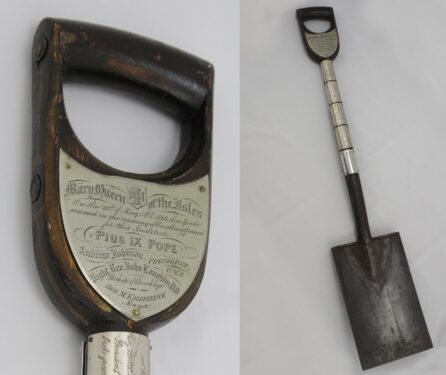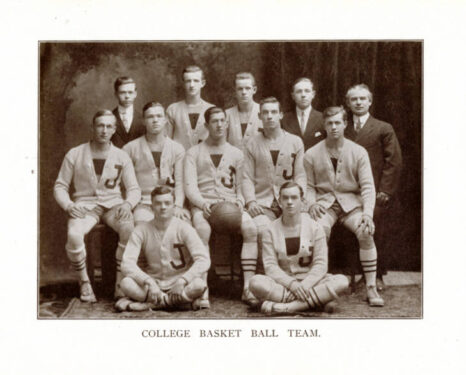
Treasure Trove
WINDSOR TERRACE — If the walls of the St. John’s University library could talk, what tales they could tell!
That’s because the library houses the university’s vast archives — a tangible and fascinating collection of items that recount the history of this famous educational institution.
St. John’s University spent the 2020-2021 school year celebrating its 150th anniversary, and as the school year ended, there was a renewed focus on the archives.
“We have thousands and thousands of documents and photographs, as well as a very large collection of artifacts. We have a body of visual material — artwork, scripts, rare books — the list goes on,” said Assistant Archivist Alyse Hennig.
The archives contain a treasure trove of materials — everything from the shovel used in the school’s groundbreaking in 1868 to a freshman “beanie” cap from 1954.
The shovel is one of Hennig’s favorite artifacts. “I just think it’s really symbolic for the anniversary year. It symbolizes the very beginning of the university’s history,” she said.
Today’s students get a kick out of the beanie. “A lot of students today are really fascinated by that because it’s very different from their current experience at St John’s,” Hennig said. “They get a little glimpse back into what it was like to be a freshman many years ago. it was actually part of the packet that you would have received at freshman orientation.”
Also among the artifacts is the “St. John’s Diary,” a 19th-century ledger listing the school’s day-to-day activities kept by its founders, the Vincentian Fathers.
History is everywhere one looks. There is the Sept. 10, 1870 edition of the New York Freeman’s Journal, and a Catholic Register newspaper with the announcement that classes had begun at the school — which was then called the College of St. John the Baptist. “The classes will be under the immediate charge of six priests who will give all their attention to the moral and intellectual advancement of their students,” the report read.
The archives contain commencement medals given to outstanding graduates in 1871 and senior class rings from 1926.
There are letters, diaries, and photographs. One of the most striking photos is one of the students who volunteered for the St. John’s Cadets during World War I and underwent military training as part of the Cadet Corps of the State of New York.
“At the beginning of the season there were few, if any, of the students who had received any previous military training, and now you have a company you can be justly proud of,” a captain wrote in a May 10, 1918 letter to St. John’s President Father John W. Moore. That letter is in the archives, too.
Sadly, there are also tributes to faculty and students who died in the Spanish Flu pandemic in 1918-1919. The Spanish Flu artifacts are bound to be of interest today as New Yorkers emerge from another pandemic: COVID-19.

The ground was broken for the college’s inaugural location, 75 Lewis Ave. in Bedford-Stuyvesant, on May 28, 1868. The school opened for classes on Sept. 5, 1870. St. John’s became a university in 1933, and 22 years later, it moved from Brooklyn to Queens.
The archive also houses historical items relating to the Catholic Church.
The Halpern Collection, a set of letters written by 36 popes and four saints between 1256 and 1946, was donated to St. John’s University in the 1960s by Seymour Halpern (1913-1997), a Queens Congressman.
Hennig stressed that all of the artifacts are handled with care.
“We do have a temperature-controlled area where we store the artifacts,” she explained. “We ask that when researchers come in, they do not have any food or drink with them and do not use any pens or markers. We only use pencils here. We ask people to wash their hands before touching anything. And we ask that certain items, photographs for example, be handled with gloves to avoid damage.”
As proof that the past is present, pieces of St. John’s history continue to come in.
Just recently, the university recently received a special gift — four slabs of stone from the original Lewis Avenue building. The stones, which were provided by St. John the Baptist Parish, the original home of the school, are inscribed: “College of St. John the Baptist-Erected 1869-Lewis Ave.” The university is now in the process of finding a permanent home for the stones.
The archives are open to anyone. “We welcome anybody who’s interested in the materials that we have,” Hennig said. “We just asked that people contact us ahead of time and make an appointment, just so we can make sure that we have a seat open for you and we can pull the materials that you’re interested in ahead of time.”

Great article and interview about the greatest Catholic university in the world. SJU is second to none.